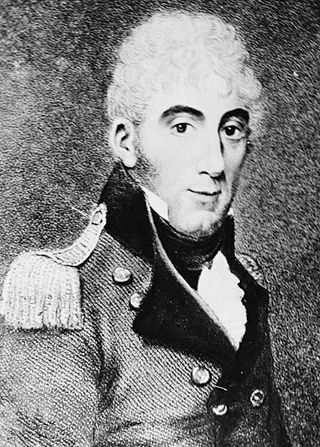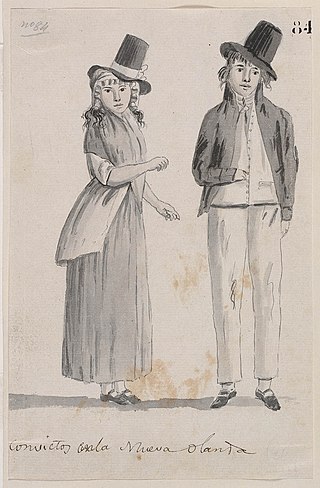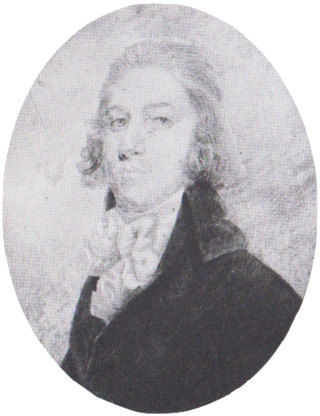
Arthur Phillip was a British Royal Navy officer who served as the first governor of the Colony of New South Wales.

The history of Norfolk Island dates back to the fourteenth or fifteenth century when it was settled by Polynesian seafarers.

The First Fleet was a fleet of 11 British ships that took the first British colonists and convicts to Australia. It comprised two Royal Navy vessels, three store ships and six convict transports. On 13 May 1787 the fleet under the command of Captain Arthur Phillip, with over 1400 people, left from Portsmouth, England and took a journey of over 24,000 kilometres (15,000 mi) and over 250 days to eventually arrive in Botany Bay, New South Wales, where a penal colony would become the first British settlement in Australia from 20 January 1788.

HMS Sirius was the flagship of the First Fleet, which set out from Portsmouth, England, in 1787 to establish the first European colony in New South Wales, Australia. In 1790, the ship was wrecked on the reef, south east of Kingston Pier, in Slaughter Bay, Norfolk Island.

Philip Gidley King was a British politician who was the third Governor of New South Wales.

Launched in 1759, the third Supply was a Royal Navy armed tender that played an important part in the foundation of the Colony of New South Wales. The Navy sold her in 1792. She then served commercially until about 1806.

The Colony of New South Wales was a colony of the British Empire from 1788 to 1901, when it became a State of the Commonwealth of Australia. At its greatest extent, the colony of New South Wales included the present-day Australian states of New South Wales, Queensland, Victoria, Tasmania, and South Australia, the Northern Territory as well as New Zealand. The first "responsible" self-government of New South Wales was formed on 6 June 1856 with Sir Stuart Alexander Donaldson appointed by Governor Sir William Denison as its first Colonial Secretary.

Colonel David Collins was a British Marine officer who was appointed as Judge-Advocate to the new colony being established in Botany Bay. He sailed with Governor Arthur Phillip on the First Fleet to establish a penal colony at what is now Sydney. He became secretary to the first couple of Governors, later being appointed to start a secondary colony where he founded the city of Hobart as the founding Lieutenant Governor of Van Diemen's Land.
The history of Australia from 1788 to 1850 covers the early British colonial period of Australia's history. This started with the arrival in 1788 of the First Fleet of British ships at Port Jackson on the lands of the Eora, and the establishment of the penal colony of New South Wales as part of the British Empire. It further covers the European scientific exploration of the continent and the establishment of the other Australian colonies that make up the modern states of Australia.
The following lists events that happened during 1788 in Australia.
The following lists events that happened during 1790 in Australia.
The following lists events that happened during 1791 in Australia.

Between 1788 and 1868 the British penal system transported about 162,000 convicts from Great Britain and Ireland to various penal colonies in Australia.

Henry Lidgbird Ball was a Rear-Admiral in the Royal Navy of the British Empire. While Ball was best known as the commander of the First Fleet's HMS Supply, he was also notable for the exploration and the establishment of colonies around what is now Australia and New Zealand. Specifically, Ball explored the area around Port Jackson and Broken Bay, helped establish the Norfolk Island penal settlement, and discovered and named Lord Howe Island.

Lieutenant Ralph Clark was a British officer in the Royal Marines, best known for his diary spanning the early years of British settlement in Australia, including the voyage of the First Fleet.

There are 20 known contemporary accounts of the First Fleet made by people sailing in the fleet, including journals and letters. The eleven ships of the fleet, carrying over 1,000 convicts, soldiers and seamen, left England on 13 May 1787 and arrived in Botany Bay between 18 and 20 January 1788 before relocating to Port Jackson to establish the first European settlement in Australia, a penal colony which became Sydney.
James Maxwell was an officer in the British Marines and member of Australia's First Fleet which established a penal colony in New South Wales in 1788.
Norfolk Islanders, also referred to as just Islanders, are the inhabitants or residents of Norfolk Island, an external territory of Australia. The Islanders have their own unique identity and are predominantly people of Pitcairn and English descent and to a lesser extent of Scottish and Irish.
Norfolk Island twice served as a penal colony, from March 1788 to February 1814, and from 1825 to 1853. During both periods the government in the Colony of New South Wales transferred convicts that had been brought to Australia on to the island.
Elizabeth Rope (1762-1837) was a First Fleet convict sentenced in 1783 at Thetford Norfolk to 7 years transportation for theft. She was transported to New South Wales on the Friendship and the Prince of Wales, disembarking in Sydney Cove on 6 February 1788. In May that year she married Anthony Rope, a convict from the Alexander, and the family became pioneering settlers.












